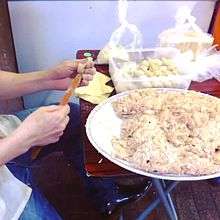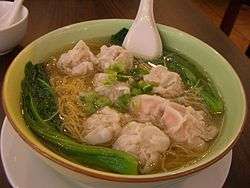Wonton
|
A Cantonese-style shrimp wonton | |
| Type | Dumpling |
|---|---|
| Course | Entree |
| Place of origin | China |
| Region or state | South China |
| Serving temperature | Hot |
| Main ingredients |
Dough: flour, eggs, water, salt Filling: ground pork, spices, garlic or green onions |
|
| |
| Wonton | |||||||||||||||||||||||||||||||
| Chinese name | |||||||||||||||||||||||||||||||
|---|---|---|---|---|---|---|---|---|---|---|---|---|---|---|---|---|---|---|---|---|---|---|---|---|---|---|---|---|---|---|---|
| Simplified Chinese |
1. 馄饨 2. 云吞 3. 抄手 4. 清汤 5. 扁食 | ||||||||||||||||||||||||||||||
| Traditional Chinese |
1. 餛飩 2. 雲吞 3. 抄手 4. 清湯 5. 扁食 | ||||||||||||||||||||||||||||||
| Literal meaning |
1. Irregularly shaped dumpling 2. cloud swallow 3. crossed hands 4. clear soup | ||||||||||||||||||||||||||||||
| |||||||||||||||||||||||||||||||
| Thai name | |||||||||||||||||||||||||||||||
| Thai | เกี๊ยว | ||||||||||||||||||||||||||||||
| RTGS | kiao | ||||||||||||||||||||||||||||||
A wonton (also spelled wantan, wanton, or wuntun in transcription from Cantonese; Mandarin: húndun) is a type of dumpling commonly found in a number of Chinese cuisines.
Preparation and filling
Wontons are made by spreading a square wrapper (a dough skin made of flour, egg, water, and salt)[1][2] flat in the palm of one's hand, placing a small amount of filling in the center, and sealing the wonton into the desired shape by compressing the wrapper's edges together with the fingers. Adhesion may be improved by moistening the wrapper's inner edges, typically by dipping a fingertip into water and running it across the dry dough to dissolve the extra flour. As part of the sealing process, air is pressed out of the interior to avoid rupturing the wonton from internal pressure when cooked.

The most common filling is ground pork and shrimp with a small amount of flour added as a binder. The mixture is seasoned with salt, spices, and often garlic or finely chopped green onion. Factory-made, frozen varieties are sold in supermarkets. Commonly, they are handmade at the point of sale in markets or small restaurants by the proprietor while awaiting customers. In markets, they are sold by the unit, without being pre-cooked.
Shapes and cooking methods

Wontons are commonly boiled and served in soup or sometimes deep-fried. There are several common regional variations of shape.
The most versatile shape is a simple right triangle, made by folding the square wrapper in half by pulling together two diagonally opposite corners. Its flat profile allows it to be pan-fried like a guotie (pot sticker) in addition to being boiled or deep-fried.
A more globular wonton can be formed by folding all four corners together, resulting in a shape reminiscent of a stereotypical hobo's bindle made by tying all four corners of a cloth together.
A related kind of wonton is made by using the same kind of wrapper, but applying only a minute amount of filling (frequently meat) and quickly closing the wrapper-holding hand, sealing the wonton into an unevenly squashed shape. These are called xiao huntun (literally "little wonton") and are invariably served in a soup, often with condiments such as pickles, ginger, sesame oil, and cilantro (coriander leaves).
Cuisine

Each region of China has its own variations of wonton, examples include Beijing, Sichuan, Hubei, Jiangnan, Jiangxi, Guangdong (Canton), Fujian, etc.
7th or 8th century old dumplings and wontons were found in Turfan.[3]
Cantonese cuisine
In Cantonese cuisine, shrimp filled wonton within minced pork is most commonly served with thin noodles to make wonton noodles. It may also be consumed with red vinegar. The soup is made from boiling shrimp shells, pork bones and dried flounder to give it a distinct taste. Hong Kong wontons were introduced to the area after World War II as street food and later indoor eateries. Wonton is served in variety of sizes with smallest being two wonton and noodles called Sai Yung.
Sichuan cuisine
In Sichuan, semi-pentagonal wonton are known as chāo shǒu (抄手, literally "crossed hands" ) since after initially folding the wonton skin into a right triangle, each end of the hypotenuse are pressed against the middle of opposite sides, creating an impression of crossed arms/hands. These are often served in a sesame paste and chili oil sauce as a dish called "red oil wonton" (红油抄手).
Shanghai cuisine
In Shanghai and its surrounding area (Jiangnan), Wonton filling is most often made with minced meat and bok choy served in chicken soup; however, Shanghai cuisine makes a clear distinction between small wontons and large wontons. The former are casually wrapped by closing the palm on a wrapper with a dab of pork filling as if crumpling a sheet of paper. These are popular accompaniments to breakfast or brunch fare. The "large" wontons are carefully wrapped (often resembling large tortellini) and a single bowl can serve as lunch or a light dinner. They are available with a large variety of fillings; a popular Shanghai fast food chain offers more than 50 varieties. One popular variety in Shanghai which is said to have originated in Suzhou is "three delicacies wonton" (san xian hun tun)which contains pork, shrimp and fish as primary ingredients.
Ningbo cuisine
Ningbo Wonton has two types, steamed Wonton and Wonton soup. Both are filled with pork and shrimp.[4] Available at many Chinese-American restaurants, these wontons became popular due to their traditional preparation.
Outside China

In American Chinese cuisine (and occasionally in Canada as well), wontons are served in two ways: in wonton soup (wontons in a clear broth), and as an appetizer called fried wontons. Fried wontons are served with a meat filling, (usually pork), and eaten with duck sauce, sweet and sour sauce, or hot mustard. A version of fried wontons are filled with a cream cheese and crab filling; these are called crab rangoon. Another version of fried wontons are filled with a mixture of cream cheese, green onions, soy sauce and garlic. These are best when eaten with sweet and sour sauce. Compared to the Far East versions, fried wontons are eaten dry.
In the Philippines, fried wontons are often called pinseques fritos (pinsec frito in the Castilian singular).[5] Pritong pinsek is the Cebuan and Tagalog name.
In Canadian Chinese cuisine, wonton soup in eateries not catering to Chinese have pork filled wontons with noodles similar to spaghetti, BBQ pork and vegetables in a clear chicken broth.
In Indonesian Chinese cuisine, they are called Pangsit. Served fried or in soup, usually with Chinese noodles.
In Peruvian-Chinese gastronomic fusion called Chifa, wonton, called Wantán in Peru, can be found fried with meat filling to eat with rice or "Tallarín saltado", and also in wonton soup or Sopa Wantán.
In Thailand, wonton is called kiao (เกี๊ยว, pronounced [kía̯w]), from Hokkien pronunciation of 饺 (Mandarin: jiǎo; "dumpling"). Wonton soup is called kiao nam (เกี๊ยวน้ำ, [kía̯w náːm]); the soup is made with chicken stock and the wontons made with a pork filling. The soup is very famous in Thailand.
In Northern Europe, mainly Russia (where they are called "pelmenyi") and Estonia (where they are called "pelmeenid"), wontons are usually filled with minced meat. They are eaten either boiled or fried, and many people eat them with vinegar and sour cream.
Chinese names
In Mandarin, they are called hundun (traditional Chinese: 餛飩; simplified Chinese: 馄饨; pinyin: húndun).
In Cantonese, they are called wantan (traditional Chinese: 雲吞; simplified Chinese: 云吞; Jyutping: wan4tan1; Cantonese Yale: wàhn tān), which literally means "swallow cloud" because when they are cooked, the dumplings float in the broth like little clouds.[6][7]
Mythology
Hundun (Wantan in Cantonese) is also a legendary faceless being in Chinese mythology and the primordial and central chaos in Chinese cosmogony, comparable with the World egg.
See also
| Wikimedia Commons has media related to: |
References
- ↑ Wonton Wrappers About.com. Retrieved: 28 February 2012.
- ↑ Homemade Wonton Wrappers Kitchen Simplicity. 13 October 2009.
- ↑ Hansen 2012, p. 11.
- ↑ Steamed Wonton and wonton soup
- ↑ http://www.comidachinademanila.com/
- ↑ Swallowing clouds in water. Retrieved 2016-04-28.
- ↑ A wonderful wonton soup recipe. Retrieved 2016-04-28.